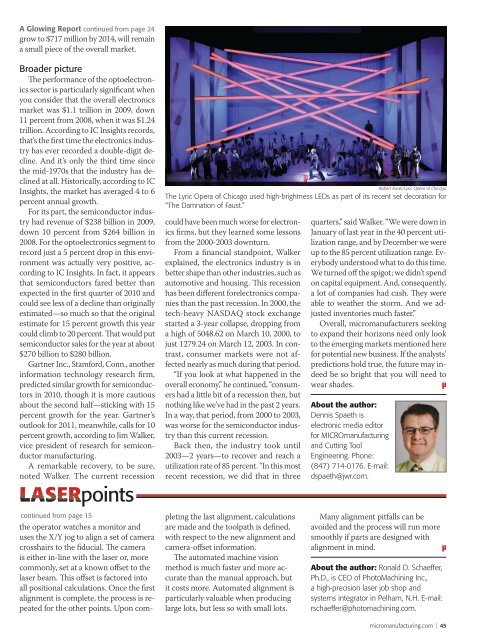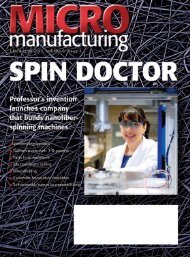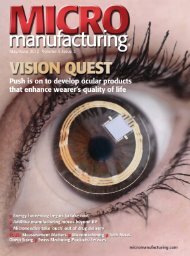Click here to view as PDF - MICROmanufacturing
Click here to view as PDF - MICROmanufacturing
Click here to view as PDF - MICROmanufacturing
Create successful ePaper yourself
Turn your PDF publications into a flip-book with our unique Google optimized e-Paper software.
A Glowing Report continued from page 24<br />
grow <strong>to</strong> $717 million by 2014, will remain<br />
a small piece of the overall market.<br />
Broader picture<br />
The performance of the op<strong>to</strong>electronics<br />
sec<strong>to</strong>r is particularly significant when<br />
you consider that the overall electronics<br />
market w<strong>as</strong> $1.1 trillion in 2009, down<br />
11 percent from 2008, when it w<strong>as</strong> $1.24<br />
trillion. According <strong>to</strong> IC Insights records,<br />
that’s the first time the electronics industry<br />
h<strong>as</strong> ever recorded a double-digit decline.<br />
And it’s only the third time since<br />
the mid-1970s that the industry h<strong>as</strong> declined<br />
at all. His<strong>to</strong>rically, according <strong>to</strong> IC<br />
Insights, the market h<strong>as</strong> averaged 4 <strong>to</strong> 6<br />
percent annual growth.<br />
For its part, the semiconduc<strong>to</strong>r industry<br />
had revenue of $238 billion in 2009,<br />
down 10 percent from $264 billion in<br />
2008. For the op<strong>to</strong>electronics segment <strong>to</strong><br />
record just a 5 percent drop in this environment<br />
w<strong>as</strong> actually very positive, according<br />
<strong>to</strong> IC Insights. In fact, it appears<br />
that semiconduc<strong>to</strong>rs fared better than<br />
expected in the first quarter of 2010 and<br />
could see less of a decline than originally<br />
estimated—so much so that the original<br />
estimate for 15 percent growth this year<br />
could climb <strong>to</strong> 20 percent. That would put<br />
semiconduc<strong>to</strong>r sales for the year at about<br />
$270 billion <strong>to</strong> $280 billion.<br />
Gartner Inc., Stamford, Conn., another<br />
information technology research firm,<br />
predicted similar growth for semiconduc<strong>to</strong>rs<br />
in 2010, though it is more cautious<br />
about the second half—sticking with 15<br />
percent growth for the year. Gartner’s<br />
outlook for 2011, meanwhile, calls for 10<br />
percent growth, according <strong>to</strong> Jim Walker,<br />
vice president of research for semiconduc<strong>to</strong>r<br />
manufacturing.<br />
A remarkable recovery, <strong>to</strong> be sure,<br />
noted Walker. The current recession<br />
LASERpoints<br />
Robert Kusel/Lyric Opera of Chicago<br />
The Lyric Opera of Chicago used high-brightness LEDs <strong>as</strong> part of its recent set decoration for<br />
“The Damnation of Faust.”<br />
could have been much worse for electronics<br />
firms, but they learned some lessons<br />
from the 2000-2003 downturn.<br />
From a financial standpoint, Walker<br />
explained, the electronics industry is in<br />
better shape than other industries, such <strong>as</strong><br />
au<strong>to</strong>motive and housing. This recession<br />
h<strong>as</strong> been different forelectronics companies<br />
than the p<strong>as</strong>t recession. In 2000, the<br />
tech-heavy NASDAQ s<strong>to</strong>ck exchange<br />
started a 3-year collapse, dropping from<br />
a high of 5048.62 on March 10, 2000, <strong>to</strong><br />
just 1279.24 on March 12, 2003. In contr<strong>as</strong>t,<br />
consumer markets were not affected<br />
nearly <strong>as</strong> much during that period.<br />
“If you look at what happened in the<br />
overall economy,” he continued, “consumers<br />
had a little bit of a recession then, but<br />
nothing like we’ve had in the p<strong>as</strong>t 2 years.<br />
In a way, that period, from 2000 <strong>to</strong> 2003,<br />
w<strong>as</strong> worse for the semiconduc<strong>to</strong>r industry<br />
than this current recession.<br />
Back then, the industry <strong>to</strong>ok until<br />
2003—2 years—<strong>to</strong> recover and reach a<br />
utilization rate of 85 percent. “In this most<br />
recent recession, we did that in three<br />
continued from page 15<br />
the opera<strong>to</strong>r watches a moni<strong>to</strong>r and<br />
uses the X/Y jog <strong>to</strong> align a set of camera<br />
crosshairs <strong>to</strong> the fiducial. The camera<br />
is either in-line with the l<strong>as</strong>er or, more<br />
commonly, set at a known offset <strong>to</strong> the<br />
l<strong>as</strong>er beam. This offset is fac<strong>to</strong>red in<strong>to</strong><br />
all positional calculations. Once the first<br />
alignment is complete, the process is repeated<br />
for the other points. Upon completing<br />
the l<strong>as</strong>t alignment, calculations<br />
are made and the <strong>to</strong>olpath is defined,<br />
with respect <strong>to</strong> the new alignment and<br />
camera-offset information.<br />
The au<strong>to</strong>mated machine vision<br />
method is much f<strong>as</strong>ter and more accurate<br />
than the manual approach, but<br />
it costs more. Au<strong>to</strong>mated alignment is<br />
particularly valuable when producing<br />
large lots, but less so with small lots.<br />
quarters,” said Walker. “We were down in<br />
January of l<strong>as</strong>t year in the 40 percent utilization<br />
range, and by December we were<br />
up <strong>to</strong> the 85 percent utilization range. Everybody<br />
unders<strong>to</strong>od what <strong>to</strong> do this time.<br />
We turned off the spigot; we didn’t spend<br />
on capital equipment. And, consequently,<br />
a lot of companies had c<strong>as</strong>h. They were<br />
able <strong>to</strong> weather the s<strong>to</strong>rm. And we adjusted<br />
inven<strong>to</strong>ries much f<strong>as</strong>ter.”<br />
Overall, micromanufacturers seeking<br />
<strong>to</strong> expand their horizons need only look<br />
<strong>to</strong> the emerging markets mentioned <strong>here</strong><br />
for potential new business. If the analysts’<br />
predictions hold true, the future may indeed<br />
be so bright that you will need <strong>to</strong><br />
wear shades. µ<br />
About the author:<br />
Dennis Spaeth is<br />
electronic media edi<strong>to</strong>r<br />
for <strong>MICROmanufacturing</strong><br />
and Cutting Tool<br />
Engineering. Phone:<br />
(847) 714-0176. E-mail:<br />
dspaeth@jwr.com.<br />
Many alignment pitfalls can be<br />
avoided and the process will run more<br />
smoothly if parts are designed with<br />
alignment in mind. µ<br />
About the author: Ronald D. Schaeffer,<br />
Ph.D., is CEO of Pho<strong>to</strong>Machining Inc.,<br />
a high-precision l<strong>as</strong>er job shop and<br />
systems integra<strong>to</strong>r in Pelham, N.H. E-mail:<br />
rschaeffer@pho<strong>to</strong>machining.com.<br />
micromanufacturing.com | 45















